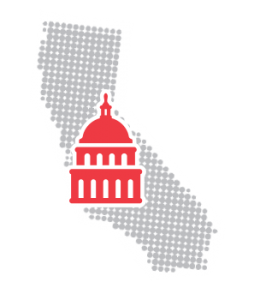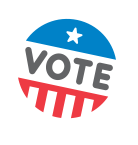November 4, 2014 California General Election
Table of Contents
- About This Election
- The State Candidate Races
- California Courts and Judges
- Propositions
- Voting is as easy as 1-2-3!
- About the Easy Voter Guide
About This Election
What to Expect in This Election
In the November 4, 2014 election, all California voters will be asked to:
- Choose a Governor and other representatives for national, state, and local government
- Decide if judges on the state’s Supreme Court should keep their positions
- Vote YES or NO on six proposed state laws
Voters will also be asked to decide on local candidates and possibly local ballot measures. What is on your ballot depends on where you live. Every registered voter will get a Sample Ballot in the mail that lists everything they can vote on.
You do not have to vote on everything. Your votes still count even if you choose to skip some things on your ballot.
Registering to Vote
U.S. citizens 18 years or older are eligible to vote. The deadline to send in the registration form is October 20, 2014. You can sign up online at registertovote.ca.gov or pick up a form at your library, post office, county elections office, or get one mailed to you by calling (800) 345-8683.
Once you are signed up, you only have to re-register if you move, change your name, or want to change
your political party.
Casting Your Ballot
You choose which way you want to vote:
- Vote in person: Each voter is assigned a polling place. Find the location on the address label of the Sample Ballot that will be mailed to you or look it up at smartvoter.org. Your polling place is open from 7 a.m. to 8 p.m. on election day.
- Vote by mail: You need to ask for a “vote by mail” ballot in writing. Send in your application no later than October 28. After you get your ballot, mark your votes, sign it, and mail it back in enough time to be received by November 4. Or you can drop it off at your polling place on election day.
For more information:
This Easy Voter Guide is nonpartisan, which means it provides neutral information that lets you make your
own decisions. Visit these websites for more nonpartisan information:
- www.easyvoterguide.org – Download this guide in five languages.
- www.smartvoter.org – Look up your personal ballot and polling place. Find information on your local and state races.
- www.sos.ca.gov/elections – In-depth Voter Information Guide about state races and propositions. Available in different languages.
The State Candidate Races
For the following offices, only the two candidates who got the most votes in the June 2014 primary election will appear on a voter’s ballot. This is because California voters approved a “Top Two” system for selecting candidates for state office. In some cases, the two candidates may be from the same political party.

Offices that represent everyone in California (elected for a four-year term)
- Governor – The highest elected official in California: Oversees most state departments and agencies. Prepares annual state budget. Approves or rejects new state laws.
- Lieutenant Governor – Next in line: Becomes Governor if the elected Governor leaves office. Has a tie-breaking vote in the State Senate. Serves on boards and commissions.
- Secretary of State – Head of elections and record keeping: Coordinates statewide elections and oversees election laws. Also keeps records about new corporations and businesses and other state databases.
- Controller – The state’s bookkeeper: Keeps track of how the state’s money is spent. Issues most checks from the state and manages collection of money due to the state. Reports on finances of state and local governments.
- Treasurer – The state’s banker: Manages the state’s investments and assets. Coordinates the sale of state bonds.
- Attorney General – Top law enforcement officer: Makes sure laws are enforced the same way across the state. Manages the state Department of Justice. Oversees sheriffs and district attorneys.
- Insurance Commissioner – Insurance overseer: Manages the state Department of Insurance. Enforces laws that insurance companies must follow.
- Superintendent of Public Instruction – Head of public schools: Manages the state Department of Education. Provides leadership and assistance to all public schools in California. Enforces education regulations.
 Offices that represent a specific district in California
Offices that represent a specific district in California
- Representative in U.S. Congress (2-Year term)
- State Senator (4-Year term; even-numbered districts will be voted on in this election)
- State Assembly Member (2-Year term)
- State Board of Equalization (state tax commission; 4-Year term)
California Courts and Judges
Judges in the higher courts get into office and stay in office in a different way than other elected officials. Judges for the Court of Appeals and the Supreme Court are appointed and then confirmed. Voters are asked to vote on whether to keep the judge after confirmation, and again after every twelve years.
In this election, all voters will be asked to vote YES or NO on whether to keep three Supreme Court judges. Some voters will also be asked whether to keep judges at the Court of Appeals, and there will be elections for judges in some County Courts.
Propositions
Propositions are proposed laws presented to the public to vote on. They may also be called ballot measures. This guide has short descriptions of the six statewide propositions being decided by voters in the November 4, 2014 election. You may also be asked to vote on local ballot measures in this election.
- Propositions 1 and 2 were placed on the ballot by the State Legislature.
- Propositions 45 through 48 have been placed on the ballot by people who collected enough signatures.
- Propositions 45, 46, and 47 are “initiatives.” A YES vote means that you support the way the proposition would change things and a NO vote means that you want to leave things the way they are now.
- Proposition 48 is a “referendum,” which asks voters to decide on a law that is already in place. A YES vote means that you support the law and want to keep it and a NO vote means you want the law overturned.
You do not have to vote on everything. Use this guide to choose the ones that are important to you and learn more about them.
| What is a bond?If you would like to vote for or against Proposition 1, it is helpful to understand what a bond is.Governments sell bonds to investors to borrow money now and then pay the bonds off over time plus interest. At current rates, to pay off the bond plus interest is about double the cost of paying for something all at once. Bonds are usually used for things that last a long time, like buildings or bridges. |
Proposition 1: Bonds for Water Supply
The way it is now:
California’s residents, businesses, and agriculture all depend on water storage, delivery, and treatment systems, many of which are out-of-date. Water systems vary across the state and some are not able to handle droughts and floods. California’s environment is also affected by changes in water supply.
What Prop 1 would do if it passes:
Allow the state to sell $7.1 billion in new bonds, and $425 million in already approved bonds, to pay for state and local projects for water supply and quality and the overall water environment.
Effect on the state budget:
The state would take on new debt of $7.1 billion and redirect $425 million in previously approved bonds. It will cost about $360 million per year to pay back these bonds over 40 years.
People for Prop 1 say:
These funds are an overdue investment in water supply and improved water management. Bonds are the best way to pay for this kind of investment.
People against Prop 1 say:
The large projects proposed in this bond will shift taxpayer dollars from local projects and other public investments such as education.
Proposition 2: State Budget Reserve
The way it is now:
The state budget has a reserve (“rainy day fund”) designed to set money aside in good years to help balance the budget in bad years. Rules for how the reserve works are in the state Constitution. This year the state’s General Fund budget is about $110 billion. The state also has about $300 billion in debts for things like retirement benefits already earned by public employees and projects like highways and buildings.
What Prop 2 would do if it passes:
Change the rules in the state Constitution about how much money goes into the state’s budget reserve and how that money can be used. The reserve would get 1.5% of the General Fund and, in good years, additional funds from taxes related to capital gains. For the next 15 years, half of the money would go toward paying off certain types of state debts. Prop 2 would also create a new state reserve for local schools and community colleges when the economy is strong. When money goes into this reserve, state law would change rules for local K-12 school district budget reserves.
Effect on state and local budgets:
Under Prop 2, state government would pay down its existing debt faster. For the next 15 years, there would be less money for other things in the state budget. Long term, less money would be spent on paying debts. The new school reserve would receive funds only occasionally—and would not affect total state funds given to schools over time. New rules for local school district budget reserves will leave some districts with smaller reserves available in bad economic times.
People for Prop 2 say:
Prop 2 will force the state government to save money in good years and pay down its debts faster.
People against Prop 2 say:
Prop 2 will create new rules that will make it harder for schools to receive adequate funding.
Proposition 45: Healthcare Insurance Rates
The way it is now:
In 1988, California voters approved having an elected Insurance Commissioner and a state department of insurance that has authority over automobile and homeowner’s insurance rates. This office reviews but does not have control over health care rates.
Most Californians with health care insurance (about 77%) are covered by either large-group employee plans or government programs. About 16% are covered by individual or small-group employer plans. Proposed rate changes for these plans are reviewed by the Department of Insurance or the state’s Department of Managed Health Care, but neither department has control over these rates.
What Prop 45 would do if it passes:
Create new rules for changes to healthcare insurance rates for individual and employer small-group plans. The state Insurance Commissioner would have to approve rate changes for these plans before they could go into effect.
Effect on the state budget:
The California Department of Insurance would have some new costs to oversee proposed rate changes. These costs would be paid by fees from insurance companies.
People for Prop 45 say:
Health insurance rates keep rising faster than inflation. Prop 45 will control health insurance costs just as rules passed by voters successfully controlled auto insurance costs.
People against Prop 45 say:
This puts too much power in the hands of the elected Insurance Commissioner and creates yet another set of complicated state rules.
Proposition 46: Medical Safety and Lawsuits
The way it is now:
Medical negligence is when a doctor provides substandard care that injures a patient. Lawsuits about medical negligence can involve economic damages and non-economic damages. Economic damages pay for the financial costs of an injury, such as medical bills or loss of income. State law limits non-economic damages, which pay for “pain and suffering,” at $250,000.
What Prop 46 would do if it passes:
- Increase the limit to $1.1 million for non-economic damages in malpractice lawsuits.
- Require drug and alcohol testing of doctors and reporting positive test results to the California Medical Board.
- Require health care workers to check a database before prescribing certain drugs so patients can’t get multiple prescriptions.
Effect on government spending:
The cost of malpractice insurance and payments of malpractice claims could increase and could also change how doctors practice medicine. Government health care spending could increase between tens of millions and hundreds of millions of dollars each year. Some of these costs might be offset by savings from the new drug database and drug and alcohol testing.
People for Prop 46 say:
Prop 46 introduces important patient safety measures, and increasing compensation for pain and suffering will hold doctors accountable for medical errors.
People against Prop 46 say:
Prop 46 will make medical insurance so high we will lose good doctors to other states, and the drug testing and database go too far in invading people’s privacy.
Proposition 47: Reducing Criminal Penalties
The way it is now:
California law sorts crimes into felonies or misdemeanors. Felonies can be graded as “violent” and/or “serious” (such as murder and rape) or graded as “nonviolent” (such as grand theft and possession of illegal drugs). Felony convictions can result in state prison or county jail time for more than one year. Misdemeanors are less serious crimes, such as petty theft and public drunkenness, which usually result in county jail time for less than a year and/or fines.
What Prop 47 would do if it passes:
Reduce the penalty for certain nonviolent felonies to misdemeanors, unless the defendant has prior convictions for particular violent and serious crimes. Any convicted felon whose crime is reclassified as a misdemeanor could get resentenced. Savings from these changes would be used for mental health and drug treatment programs, K-12 schools, and victim services. Some offenders who have completed a sentence for a felony could have their convictions changed to misdemeanors.
Effect on the local and state budget:
State savings from fewer prison sentences are estimated to be in the low hundreds of millions of dollars annually. These savings will be applied to programs and services designed to help keep people out of prison and jail. County cost savings are estimated to be several hundred million dollars annually, primarily due to people serving shortened terms in jail.
People for Prop 47 say:
This will reduce high prison spending on low-level nonviolent crimes. Law enforcement resources will be focused on violent and serious crimes.
People against Prop 47 say:
Prop 47 will burden our criminal justice system; it will overcrowd jails with inmates moved from state prison and jam the courts with resentencing hearings.
Proposition 48: Indian Gaming Agreements
The way it is now:
State law allows Indian tribes to operate casinos on Indian lands if the tribe, state, and federal government agree. Currently 58 tribes conduct casino-style gambling which is not legal elsewhere in California.
New agreements (“compacts”) have been negotiated with two tribes, the North Fork Rancheria and the Wiyot Tribe. The North Fork would be able to open a casino and hotel in Madera County on property not connected to their reservation. The Wiyot would agree not to open a casino in Humboldt County in return for a share of the North Fork casino’s profits. Some Californians are concerned about these agreements and gathered enough signatures to put them to a vote.
What Prop 48 would do if it passes:
A YES vote would allow the North Fork to proceed with the casino in Madera County and also prohibits the Wiyot from opening a
casino in Humboldt County.
A NO vote rejects these compacts and both tribes would need to seek new agreements if they wanted to construct or operate casinos.
Effect on local and state budgets:
$10 million per year would go to state and local governments over 20 years. Local governments near the new casino would receive one time payments totaling $16 million to $35 million.
People for Prop 48 say:
The North Fork casino has local support and would create over 4,000 jobs to give a much needed boost to the local economy.
People against Prop 48 say:
These agreements change the rules about where tribes can operate casinos and will open the door to more gambling.
Voting is as easy as 1-2-3!
California General Election: Tuesday, November 4, 2014
1. Sign Up
Fill out a voter registration form by October 20, 2014.
- You are eligible to vote if you are a U.S. citizen, 18 years or older.
- You can pick up a voter registration form at your library or post office, have a registration form mailed to you by calling 1-800-345-8683, or fill out the form online at www.registertovote.ca.gov.
- You must fill out a new voter registration form when you move to a new address, change your name, or want to change your political party.
2. Get Ready
Before you vote, learn about what you will be voting on.
- All registered voters receive two things in the mail:
- A Sample Ballot that lists everything that will be on your ballot along with where you vote (your “polling place”).
- An Official Voter Information Guide about statewide candidates and propositions.
- In addition to this nonpartisan Easy Voter Guide, find more information about everything on your ballot and where your polling place is located at www.smartvoter.org.
 3. Vote!
3. Vote!
You can choose to vote at your polling place or use a “vote by mail” ballot.
- For voting in person, the polls are open from 7 a.m. until 8 p.m. You may also be able to vote before election day at your county elections office.
- To vote by mail, use the form in your Sample Ballot to request a “vote by mail” ballot. The deadline to ask for one is October 28. When you receive your “vote by mail” ballot, fill it out and mail it back in time for it to arrive by election day. You may also drop it off at any polling place in your county on election day.
The Easy Voter Guide is a project of the League of Women Voters of California Education Fund and has been providing new voters and busy voters with nonpartisan information for statewide elections in California since 1994. Community reviewers help ensure the guide is easy to read and understand. The proposition explanations in this guide are based on information from the nonpartisan Legislative Analyst’s Office. The arguments for and against each proposition are taken from the arguments in the Secretary of State’s Official Voter Information Guide and other sources.
Every effort is made to ensure the accuracy and completeness of the information presented in the Easy Voter Guide. Additional information made available after the guide is printed and any other corrections are posted at www.easyvoterguide.org. Please send questions or suggestions about this guide to easyvoter@lwvc.org.
The Easy Voter Guide is made possible in part by the U.S. Institute of Museum and Library Services under the provisions of the Library Services and Technology Act, administered in California by the State Librarian. The League of Women Voters® of California Education Fund is a 501(c)(3) nonpartisan organization that encourages informed and active participation in government and works to increase understanding of major public policy issues. For more information, go to www.cavotes.org.





Comments are closed, but trackbacks and pingbacks are open.